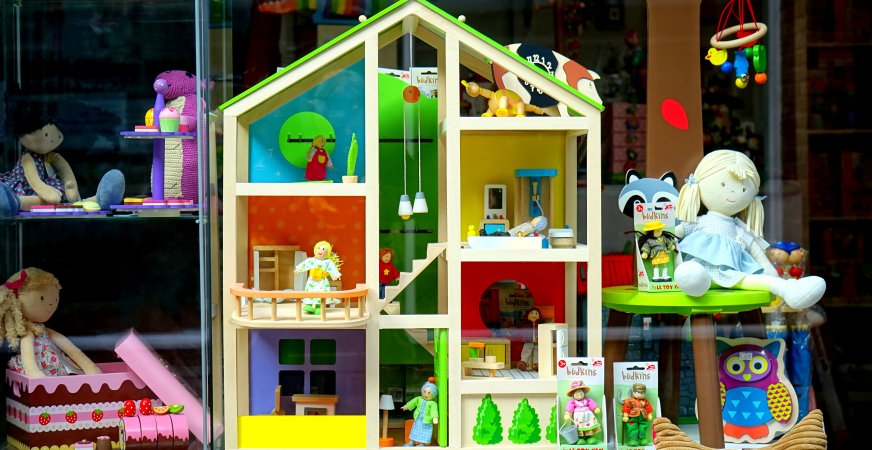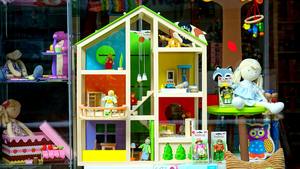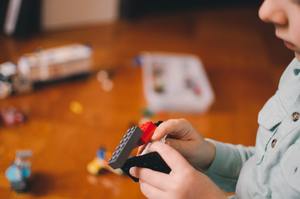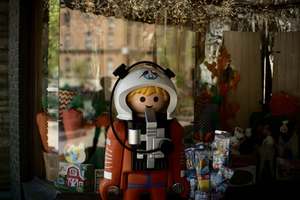
Toy Safety Guidebook: Everything Caregivers Need to Know

Whether you are a parent or a caregiver, or even a babysitter, there is a good chance that you spend most of your time as a bundle of nerves.
After all, it is only when you have to take care of little kids that you truly begin to understand all of the dangers surrounding them.
One main issue, in particular, is toys.
While you may want your little one to have as many toys as possible, it isn’t always so easy to determine which ones are safe and which toys should be kept out of your child’s reach without supervision.
And it is important to understand the difference – at last count, it was estimated that toys were responsible for injuries for around a quarter of a million children.
If you want to prevent your child from becoming one of these statistics, we have just the guide for you.
Here, you will learn about all of the things that you need to be aware of, every time that you buy a toy:
Guidelines for Choosing Age-Appropriate Toys

Normally, when you think of age-appropriate toys, you focus on whether your child is physically and mentally capable of playing with that object.
However, there is a secondary point to consider in terms of what may be age appropriate for your child.
This is to figure out whether any of the parts of a toy pose a risk to your child, depending on how old they are.
Here is what you should think about:
1. Size
As a rule of thumb, the younger the child, the larger the toy should be.
As you probably have already witnessed most babies and small children have a tendency to put all objects in their mouth.
So, if the toy contains smaller pieces, there is a greater chance of your little one swallowing the toy and choking.
Now, it is important not to just think of the toy as a whole. You should also look at any parts or pieces that can be removed and then inserted into the mouth or nose.
As a general rule, if your child is younger than 3 years old, you should not give them a toy that is less than 1.25 inches in diameter or has a part with smaller dimensions than this.
You should also watch out for thin pieces of fabric, such as strings. If a toy has any form of a string, it is imperative that they are no longer than 7 inches.
2. Common Choking Hazards
Two of the most common choking hazards are balloons and magnets.
Balloons are particularly dangerous in their uninflated state or if they have been torn or broken. So, if a toy contains any type of balloon, you shouldn’t buy it for your toddler.
The government now requires companies to use magnets that are far less powerful than they once were. Still, it can be rather harmful to your child if it is swallowed.
If more than one magnet is swallowed, there is a chance that they may stick together and get lodged in a child’s intestines.
To be on the safe side, you shouldn’t give your child a toy that has small magnets that can be easily dislodged.
3. Alternative Uses
You also need to keep an eye on toys for older kids too. While there is less of a chance of choking with children upwards of 6 years, there are still lots of other hazards.
In particular, you may have noticed that kids are exceptional at turning almost any toy into a weapon.
This is why you will need to pay special attention to anything that may have darts, pellets, or ‘bullets’ of any kind.
Toys with pointed ends are rarely a good idea. If you do want to give your child a game that involves darts or arrows, make sure that they are soft-tipped to avoid injury.
Materials in Toys – What You Need to Be Vigilant About

If you take a look at the materials listed on any toy label, you’ll probably feel like you need a chemistry degree just to be able to keep up with the jargon.
The good news is that you only really have to watch out for a few terms to be able to know what is safe for your child.
1. Lead
This is arguably one of the most dangerous substances for your child, especially if it is consumed. This is why you need to be careful of any toys that have painted surfaces.
You should verify that the paint that has been used is lead-free. If not, it is always better to err on the side of caution and stay clear of the product.
2. Paint
You don’t need to keep your children away from crayons or watercolors. You simply need to ensure that the paint is non-toxic.
Paints that are meant for children will contain a “non-toxic” label if they have used the right products. So, you should keep an eye out for that.
3. Fabrics
There are two main concerns with fabric – flammability, and allergies.
So, when choosing plush toys, look for fabrics that are either flame retardant or flame resistant.
Since kids have such delicate and sensitive skin, they can develop allergies to synthetic fabrics. This is why it is a good idea to stick with cotton, wool, or linen stuffed toys.
Just remember that any plush toys should be washable so that you can keep them clean.
It is a good idea to stay away from older toys, even if they have been passed down from other family members.
See, the regulations weren’t all that tight in previous generations, meaning that some of those toys could contain toxic materials.
Determining the Durability of Toys
One thing that you should certainly avoid is toys that are made from thin or flimsy materials.
This is because there is a greater chance of these objects breaking. You are then left with pointed and sharp pieces that can either be swallowed or cause injury to your child.
As a result, one of the first things that you will need to check is how easily a particular toy can be cracked or damaged in any way.
At the same time, the toys should be lightweight so your little one can’t be hurt if the object should fall on them.
The Toy Design: Is It Safe?

Once you know that the toy will not fracture easily, you need to consider the design of the object.
As you can imagine, you should stay away from anything that has sharp or pointed edges.
This is especially important if the toy is made from a tough material such as metal.
Design is especially significant if you are thinking about getting your child a ride-on toy.
As long as your child can sit up without being supported, ride-on toys are usually a viable option for them.
However, before letting your child ride on such a toy, you will need to first check that it is stable.
This means that it can’t be toppled over either while your child is seated on the toy or while he or she is pushing it around.
Being Forewarned: How to Do Your Research on Toys
When it comes to toy safety, it is all about being preemptive. This is why it is vital that you research the toys that you want to buy beforehand.
In doing this, you will be able to take notice of any red flags that may have been raised, regarding the manufacturer or that particular plaything.
Here is how you can go about your research:
1. Check with Government Agencies
The first thing that you will need to do is to see whether or not the toy in question, has been recalled for any reason. The easiest way to do this is to check with government regulatory sites.
The US Consumer Safety Product Safety Commission (CSPSC) has a list of recalls that cover a variety of categories.
They also provide you with recall lawsuits as well as various violations committed by manufacturers. All of this information should let you know which toy companies to avoid.
2. Know the Country of Origin
Now, you should understand that each country has its own list of materials and substances that are considered to be safe or harmful.
So, what might be thought of as safe in one nation may actually be deemed dangerous in another.
This is why you should always take a look at the country that the toy came from – was it manufactured in a place with strict laws?
If you can’t trust the safety standards of the place where the toy was constructed, then you may want to avoid getting it for your little one.
3. Read the Reviews
Federal regulatory boards pale in comparison to concerned parents. This is why you shouldn’t only rely on government websites when it comes to your research.
A good way to keep your finger on the pulse regarding toy safety issues is to read the reviews of various products. This will give you an idea of the experiences other parents have had.
If you find that similar problems have been reported across the board, then you are aware of what to be careful with when choosing that specific toy.
How to Understand What Toy Labels are Telling You

By law, companies are required to put various safety warnings on the packaging of their toys.
Of course, to be able to make full use of this information, you have to first understand what the toy labels are actually telling you…
1. Region of Origin
There are a few ways to figure out where a toy was made and, as such, what regulations the manufacturing company had to adhere to:
- CE Stamp: you have probably seen the letters CE surrounded by a box on a number of products but never actually stopped to think about what they mean. Well, these letters let you know that the toy in question has been manufactured within in the EU and has met all of the required safety standards.
- US-Made: if you want to know if a toy is made in the US, then you should check for the name and the complete address of the manufacturer, location of production, and origin of country for the toy. This information is required for all toys sold in the US market, regardless of where they have been manufactured.
2. Warning Labels
Irrespective of where the toy was made, there should be certain warning labels on all toys. This provides information that should let you know whether the toy is dangerous to your child.
Warning Signs
For USA:
There will always be a warning symbol present on toy packaging that is sold in the US. This is an exclamation point within a triangle.
This will be followed by a message that contains the Signal Word, Statement of Hazard, and Other Materials.
So, it will look something like this:
WARNING:
Choking Hazard – small parts.
Not for children under 3 years.
Now, depending on the exact components of the toy, the message may change. However, for the most part, they all look like this.
This sign usually indicates that at least one part of the toy has a piece that is between 1/32 and 3/64 inches big.
For Europe:
There is typically a much smaller symbol on toy packaging in Europe.
There is the warning symbol followed by a child’s face with a recommended age limit. This is typically 0 – 3 and means that the toy is not suitable for a child under the age of 3.
3. Safety Certification
Now, the other thing that you need to check is that each toy has passed the rigorous safety measures imposed by each country. So, here are the codes to look out for:
- USA: ASTM F963-11 and 16 CFR 1500.50
- Europe: EN 71-1:2011 + A2:2013
- Canada: Canada Consumer Product Safety Act, Toys Regulations (SOR/2011-17)
- Australia: AS/NZS ISO 8124.1:2013
- Japan: ST2012
- China: GB6675:2003 + A1:2005-
What to Know About Choosing Electronic Toys

These days, most of the toys that you buy have some sort of electronic wiring. Because of these, there are a few safety checks that you will need to perform:
1. Batteries
First and foremost, if the toy contains batteries, they should be enclosed in an area that has a lid that needs to be screwed in.
This will ensure that your child will not be able to get the batteries loose and place them in his or her mouth.
Also, if you are planning on storing that toy for a longer period of time, you should first take the batteries out.
This way, there will be no chance of the batteries leaking fluid that your child can come into contact with.
2. Exposed Wiring
You will need to check that there are no wires poking out of the toy at any given time. This includes battery-operated plush toys as well.
These can poke or injure your child. So, always perform a cursory examination of these toys to ensure that there are no wires sticking out.
3. Sound Levels
Now, you can attest to just how annoying noisy toys can be. What you may not realize, though, is that these toys aren’t just irritating, they can also be damaging to your child’s hearing.
Ideally, your child shouldn’t be exposed to anything louder than 55 decibels for long periods of time. So, if a toy seems particularly loud, it is best to keep it away from your little one.
Also, you should let your child play with sound-emitting toys for short bursts so that they don’t hurt their hearing in any way.
Related Guides: Best RC Cars Under $100
Tips for Keeping Your Kids Safe While They are Playing With Their Toys

Here are some important points to remember while your little ones are playing with their toys.
This will further reduce the risk of harm or injury:
- Discard the packaging immediately. Sometimes you pay so much attention to how safe a toy is that you forget that the packaging can be quite dangerous. This is why you should get rid of all of the plastic, cardboard, and any other bits and pieces that may come with the toy.
- Always keep an eye on your kids. Regardless of what they are playing with, you should never leave the room or lose attention when your little one is playing with a toy. This is the only real way to prevent anything from happening to your child.
- Put toys away immediately. If your child is old enough, you should get them into the habit of putting their toys away. This will prevent them from stepping on or tripping over anything left on the floor. You should also remind older kids to keep small or heavy toys out of the reach of their younger siblings.
- Keep up with maintenance. You should keep in mind that even the most well-built toy can wear down with use and time. This is why you should keep checking on the toys to make sure they haven’t developed tears, splinters, cracks or any other types of damage.
There is no denying that there is quite a lot to digest regarding toy safety. However, by knowing how to pick the right toys, you get one step closer to keeping your little one safe and healthy.
So, let us know – are there any safety tips that you like to follow when picking out toys for your little one?
Related Guides: 5 Best Board Games for Adults
